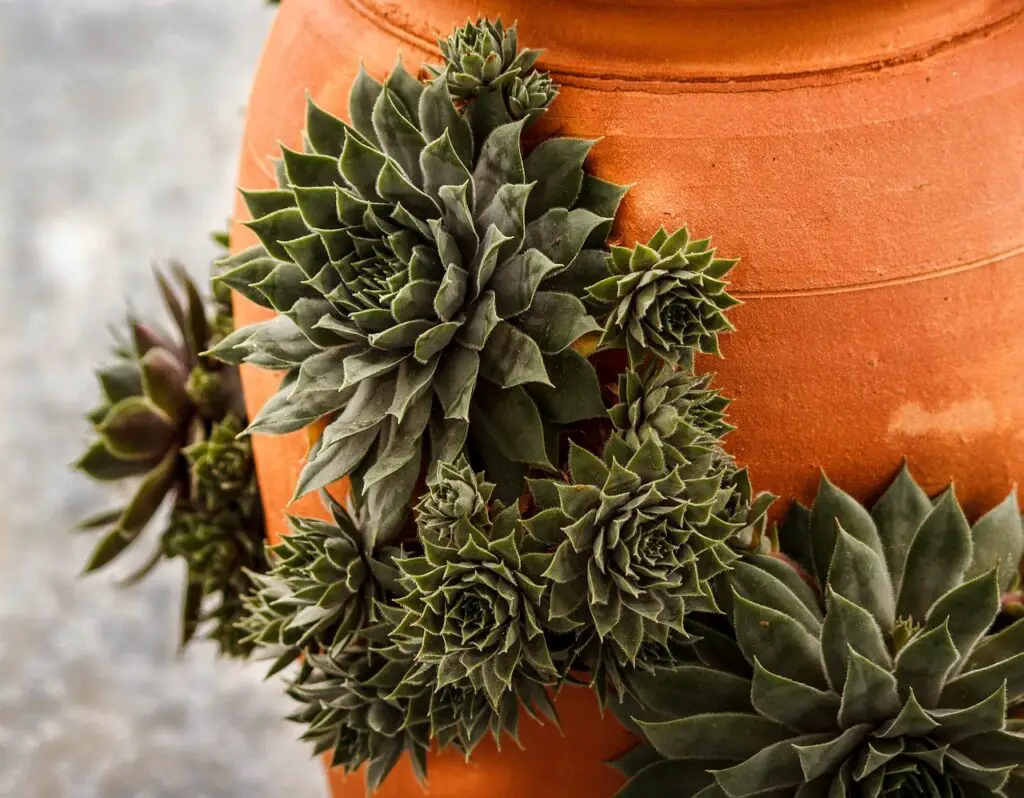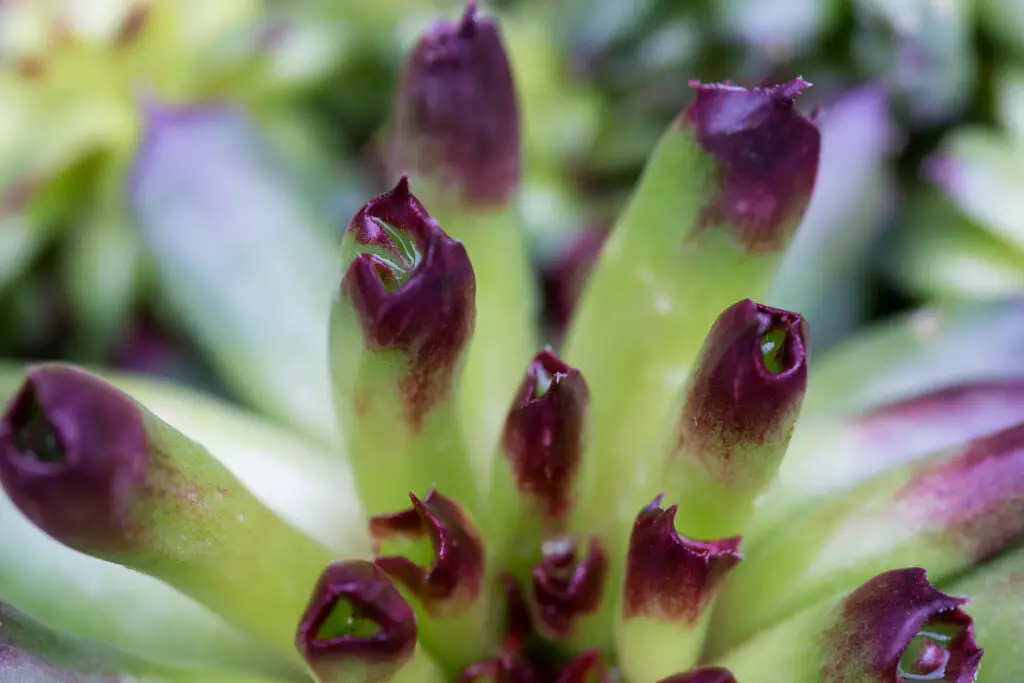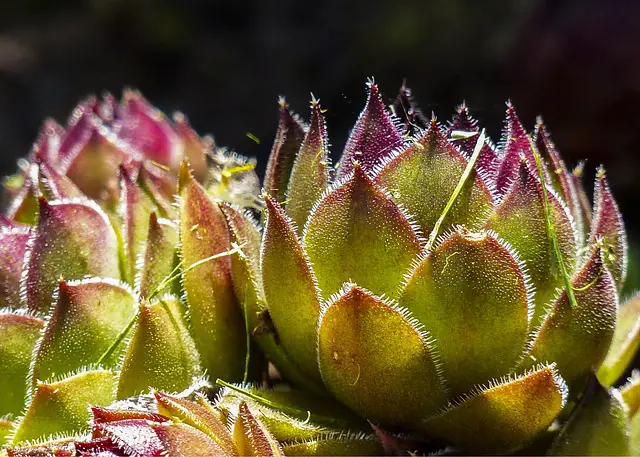Hen and chick plants, also known as houseleeks, are popular succulents that are easy to grow and maintain. However, sometimes these plants can start to droop and wilt, which can be a cause for concern for plant owners.
Understanding the signs of hen and chick plant drooping and the common causes can help plant owners take the necessary steps to revive their plant and prevent future drooping.
One of the most common causes for a drooping hen and chick plant is improper watering. Overwatering or underwatering can cause the plant to wilt and lose its ability to hold upright.
Additionally, using soil that doesn’t drain well enough can also lead to drooping. Lack of proper lighting can also cause hen and chick plants to droop and wilt, as they need good sunlight to grow healthy and beautiful.
Key Takeaways on Hen and Chick Plant Drooping
- Hen and chick plants are popular succulents that are easy to grow and maintain.
- Improper watering and lack of proper lighting are common causes for a drooping hen and chick plant.
- Understanding the signs of a drooping hen and chick plant and the common causes for drooping can help plant owners take the necessary steps to revive their plant and prevent future drooping.
Also don”t miss:
Understanding Hen and Chick Plants

Hen and Chick plants are a type of succulent plant that belongs to the Crassulaceae family. They are also known as Sempervivum or Houseleek.
These hardy succulents are native to Europe and North Africa, and they have become popular among gardeners all over the world due to their unique appearance and low maintenance requirements.
The botanical name for Hen and Chick plants is Sempervivum tectorum. The name Sempervivum means “always alive” in Latin, which is a fitting name for these plants since they are known for their ability to thrive in harsh conditions.
They are called Hen and Chick plants because the parent plant, or “hen,” produces smaller rosettes, or “chicks,” around it.
Hen and Chick plants are easy to care for and can be grown both indoors and outdoors. They prefer full sun to light shade and well-draining soil.
Overwatering is a common mistake that gardeners make with these plants, which can cause the leaves to become soft and mushy. On the other hand, underwatering can cause the plant to droop and lose its ability to hold upright.
Hen and Chick plants come in a variety of colors and textures, making them a popular choice for gardeners who want to add some diversity to their garden.
They are also great for rock gardens, containers, and as ground cover. Overall, Hen and Chick plants are a versatile and low-maintenance succulent that can add a unique touch to any garden.
Hen and Chick Plant Drooping
Hen and chick plants are succulent plants that are known for their hardiness and resilience. However, they can still experience problems, including drooping.
Here are some signs that your hen and chick plant may be drooping:
- Wilting Leaves: If the leaves of your hen and chick plant are wilting, it’s a sign that the plant is not getting enough water. The leaves may appear limp and lifeless, and they may droop down towards the ground.
- Shriveled Leaves: Another sign of a drooping hen and chick plant is shriveled leaves. When the leaves of the plant are not getting enough water, they may become dry and shriveled, which can cause them to droop.
- Brown Leaves: If the leaves of your hen and chick plant are turning brown, it’s a sign that the plant is not getting enough water or is getting too much water. Brown leaves can also be a sign of disease or insect infestation, so it’s important to inspect the plant closely to determine the cause.
- Stunted Growth: A drooping hen and chick plant may also exhibit stunted growth. If the plant is not getting enough water, it may not grow as quickly as it should, and the leaves may become smaller and less robust.
If you notice any of these signs in your hen and chick plant, it’s important to take action to address the problem.
This may involve adjusting the watering schedule, providing more or less sunlight, or treating the plant for disease or pests. With proper care, your hen and chick plant can recover from drooping and continue to thrive.
Common Causes for Drooping

Hen and chick plants are hardy succulents that can tolerate a wide range of conditions, but they can still experience drooping for a variety of reasons. Here are some common causes:
1. Improper Watering
Improper watering is the most common cause of drooping in hen and chick plants. Overwatering can lead to root rot, which can cause the plant to wilt and droop. On the other hand, underwatering can cause the leaves to lose their ability to hold upright, resulting in a droopy appearance.
2. Lack of Light
Hen and chick plants require full sun or bright light to grow healthy and beautiful. Lack of light or improper lighting conditions can cause the plants to get droopy and wilted leaves. If the plant is not getting enough light, it may stretch out and become leggy.
3. Temperature and Humidity
Hen and chick plants prefer warm and dry conditions. If the temperature is too low or the humidity is too high, the plant may become stressed and start to droop.
4. Disease and Infestation
Hen and chick plants can be susceptible to disease and infestation, which can cause the plant to droop.
Fungal leaf spots, root rot, and aphids, mealybugs, and spider mites are common problems that can affect the plant’s health.
Role of Soil and Drainage
The soil and drainage play a crucial role in the health of hens and chick plants. These plants require well-draining soil to grow properly.
If the soil is too wet, it can lead to root rot and cause the plant to droop. On the other hand, if the soil is too dry, the plant may also droop as it is not getting enough water.
To ensure proper drainage, it is recommended to use a well-draining soil mix. This can be achieved by mixing potting soil with gravel or sand.
The gravel or sand helps to improve the drainage of the soil and prevent water from accumulating around the roots of the plant.
It is also important to ensure that the pot or container has proper drainage holes. This will allow excess water to drain out of the soil and prevent it from becoming waterlogged.
If the pot does not have drainage holes, it can be difficult to control the amount of water the plant is receiving and lead to overwatering.
In addition to using a well-draining soil mix, adding compost to the soil can also help to improve its quality. Compost is rich in nutrients and can help to promote healthy growth in hens and chicks plants.
Plant Health and Life Cycle

Hen and chick plants are succulent perennials that are known for their hardiness and ease of care.
However, like any other plant, they can experience health issues that can cause them to droop or die. It is important to understand the life cycle of these plants to ensure their overall health.
Hen and chick plants are monocarpic, which means they produce flowers only once in their lifetime. The mother plant, also known as the hen, will produce a flowering stalk, which will eventually produce seeds.
After the plant has produced seeds, it will die. This is a natural part of the plant’s life cycle, and there is nothing that can be done to prevent it.
It is important to note that the offspring of the hen plant, also known as the chicks, will continue to grow and produce new plants. These chicks can be removed from the mother plant and replanted to ensure a continuous supply of healthy plants.
To ensure the overall health of hen and chick plants, it is important to provide them with the right growing conditions.
These plants prefer full sun, but can also grow in partial shade. They also require well-draining soil, as they are susceptible to root rot if left in standing water.
Overwatering can also cause health issues in hen and chick plants. It is important to allow the soil to dry out completely between waterings to prevent root rot.
Additionally, removing dead leaves and stems can help improve air circulation around the plant and prevent issues such as fungal infections.
Caring for Your Hen and Chick Plant
Hen and chick plants are easy to care for, but they still require some attention to keep them healthy and thriving. Here are some tips to help you care for your hen and chick plant:
1. Soil
Hen and chick plants are not picky about their soil, but they grow best in a sandy or gravelly mix that is well-draining. If the soil is too dense or compacted, it can lead to root rot and other issues. Make sure to choose a pot with drainage holes to allow excess water to escape.
2. Watering
Hen and chick plants do not need much water at all. In fact, they are more likely to suffer from overwatering than underwatering. It is best to water them sparingly, allowing the soil to dry out completely between waterings. If the leaves start to look wrinkled or wilted, it is a sign that the plant needs water.
3. Light
Hen and chick plants prefer bright, indirect sunlight. They can tolerate some direct sunlight, but too much can cause the leaves to burn.
If you are growing your hen and chick plant indoors, make sure to place it near a window that receives plenty of light. If you do not have access to natural light, you can use artificial grow lights to provide the plant with the light it needs.
4. Transplanting
If your hen and chick plant outgrows its pot, it may be time to transplant it into a larger container. Choose a pot that is slightly larger than the current one and fill it with fresh soil.
Gently remove the plant from its old pot and place it in the new one, making sure to cover the roots with soil. Water the plant thoroughly after transplanting.
5. Neem Oil
If your hen and chick plant is suffering from pests or diseases, neem oil can be an effective solution.
Neem oil is a natural insecticide and fungicide that can help control a range of common plant problems. Dilute the neem oil according to the instructions on the label and apply it to the plant using a spray bottle.
Propagation of Hen and Chick Plants
Hen and chick plants are easy to propagate and multiply. The most common method of propagation is through offsets. The offsets are the smaller rosettes that grow from the parent rosette, also known as the “hen.”
These offsets are connected to the main plant through a stolon. Ground-hugging plants, such as hen and chick plants, require waiting until the offsets reach a diameter of 1 ½ inches to 2 inches before propagating them.
Another method of propagation is through seeds. However, this method is not as common as propagating through offsets. The parent plant will produce seeds after flowering, which can be collected and sown.
Propagation through seeds is a longer process than propagation through offsets, as it takes time for the seeds to germinate and grow into mature plants.
Propagation can also occur through multiplication of shoots. This method is similar to propagating through offsets, as the shoots grow from the parent rosette and can be separated to create new plants.
To propagate through offsets, carefully remove the offset from the parent plant, ensuring that the stolon is still attached. Allow the offset to dry for a few days, then plant it in well-draining soil. Water the soil sparingly until the offset has established roots and a new plant has formed.
Propagation through seeds requires collecting the seeds from the parent plant after flowering and sowing them in well-draining soil. Water the soil regularly and ensure that the seeds receive adequate sunlight. Germination can take several weeks to several months.
Propagation through multiplication of shoots involves separating the shoot from the parent plant and planting it in well-draining soil. Water the soil sparingly until the shoot has established roots and a new plant has formed.
Hen and Chick Plants as Houseplants

Hen and Chick plants are a type of succulent that make excellent houseplants due to their low-maintenance nature. They are perfect for those who want to add a touch of greenery to their homes without having to spend too much time caring for their plants.
One of the great things about Hen and Chick plants is that they can grow in a variety of environments. They are particularly suited to wall crevices and other tight spaces, making them a great choice for those who want to add some greenery to their homes but don’t have a lot of space to work with.
When it comes to caring for Hen and Chick plants, it’s important to remember that they need plenty of sunlight to thrive. However, too much direct sunlight can cause sunburn, so it’s important to find a balance. Plants that are not getting enough sunlight may start to droop and stretch, which can make them look less attractive.
To prevent stretching and encourage healthy growth, it’s important to make sure that Hen and Chick plants are getting enough light. If they are not getting enough light, they may start to grow tall and thin, which can make them more susceptible to drooping.
Another important factor to consider when caring for Hen and Chick plants is photosynthesis. These plants rely on photosynthesis to produce energy, so it’s important to make sure that they are getting enough light to support this process. If they are not getting enough light, they may start to droop and lose their vibrant colors.
Frequently Asked Questions
How do I revive a drooping succulent?
To revive a drooping succulent, you need to identify the cause of the drooping. If the plant is overwatered, you need to reduce the watering frequency and ensure that the soil is well-drained.
If the plant is underwatered, you need to water it more frequently. Also, check if the plant is getting enough sunlight and if the soil has enough nutrients.
What causes Sempervivum to become mushy?
Sempervivum can become mushy due to overwatering or waterlogging. When the plant is overwatered, the roots cannot absorb oxygen, leading to root rot. Root rot causes the leaves to become mushy and eventually die.
What are common problems with Sempervivum?
Common problems with Sempervivum include overwatering, underwatering, pests, and diseases. Overwatering can cause root rot, while underwatering can cause the plant to wilt.
Pests such as mealybugs and spider mites can also attack the plant, causing stunted growth and yellowing leaves. Diseases such as leaf spot and powdery mildew can also affect the plant.
Can cats and kittens safely be around hens and chick plants?
Hens and chick plants are generally safe for cats and kittens. However, it is important to note that some cats may be attracted to the plant and may try to eat it.
If a cat ingests a large amount of the plant, it can cause vomiting and diarrhea. It is advisable to keep the plant out of reach of cats and kittens.
What are some ways to fix droopy leaves on plants?
To fix droopy leaves on plants, you need to identify the cause of the drooping. If the plant is overwatered, reduce the watering frequency and ensure that the soil is well-drained.
If the plant is underwatered, water it more frequently. If the plant is not getting enough sunlight, move it to a brighter location.
Do hens and chick plants require a lot of sun to thrive?
Hens and chick plants require full sun to partial shade to thrive. They can tolerate hot and dry conditions, making them suitable for outdoor gardens in warm climates. However, in areas with intense heat, it is advisable to provide some shade to prevent the plant from drying out.

Hey, I’m Lisa and I’ve been an avid gardener for over 30 years. I love writing, talking and living in the garden! Feel free to connect with me on my socials below


